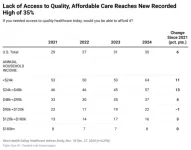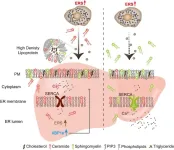(Press-News.org) NEW YORK, NY (April 2, 2025)--
April 2, 2025—An AI tool that analyzes nurses’ data and notes detected when patients in the hospital were deteriorating nearly two days earlier than traditional methods and reduced the risk of death by over 35%, found a year-long clinical trial of more than 60,000 patients led by researchers at Columbia University.
The new AI tool, CONCERN Early Warning System, uses machine learning to analyze nursing documentation patterns to predict when a hospitalized patient is deteriorating before the change is reflected in vital signs, allowing for timely, life-saving interventions.
In the study, CONCERN shortened the average hospital stay by more than half a day and led to a 7.5% decrease in risk of sepsis. Patients monitored by CONCERN were roughly 25% more likely to be transferred to an intensive care unit compared to those who had usual care.
“Nurses are particularly skilled and experienced in detecting when something is wrong with patients under their care,” said Sarah Rossetti, lead author of the study and an associate professor of biomedical informatics and nursing at Columbia University. “When we can combine that expertise with AI, we can produce real-time, actionable insights that save lives.”
The findings were published today in Nature Medicine.
CONCERN Reflects Nurses’ Concerns
Nurses often recognize subtle signs that a patient is deteriorating, such as pallor change or small changes in mental status. But their concerns, noted in a patient’s electronic health record, may not cause immediate intervention, such as transfer to an intensive care unit.
CONCERN analyzes when nurses identify and respond to these small, but meaningful changes, by looking at nurses increased surveillance of patients, including frequency and time of assessments,, in a model that generates hourly, easy-to-read risk scores to support clinical decision-making.
“The CONCERN Early Warning System would not work without the decisions and expert opinions of nurses’ data inputs,” said Rossetti. “By making nurses' expert instincts visible to the entire care team, this technology ensures faster interventions, better outcomes, and ultimately, more lives saved.”
Additional Information
The paper “Real-time surveillance system for patient deterioration: a pragmatic cluster-randomized 2 controlled trial of the CONCERN Early Warning System,” was published in Nature Medicine on April 2.
All authors (from Columbia unless noted): Sarah C. Rossetti, Patricia C. Dykes (Brigham and Women’s Hospital), Chris Knaplund, Sandy Cho (Newton-Wellesley Hospital), Jennifer Withall, Graham Lowenthal (Brigham and Women’s Hospital), David Albers, Rachel Y. Lee, Haomiao Jia, Suzanne Bakken, Min-Jeoung Kang (Brigham and Women’s Hospital), Frank Y. Chang (Brigham and Women’s Hospital), Li Zhou (Brigham and Women’s Hospital), David W. Bates (Brigham and Women’s Hospital), Temiloluwa Daramola, Fang Liu (University of Pennsylvania), Jessica Schwartz-Dillard, Mai Tran, Syed Mohtashim Abbas Bokhari, Jennifer Thate (Siena College), and Kenrick D. Cato (University of Pennsylvania).
The study was funded by grants from the National Institutes of Health (NINR 1R01NR016941 and T32NR007969).
Disclosures are noted in the paper.
###
Columbia University Irving Medical Center (CUIMC) is a clinical, research, and educational campus located in New York City. Founded in 1928, CUIMC was one of the first academic medical centers established in the United States of America. CUIMC is home to four professional colleges and schools that provide global leadership in scientific research, health and medical education, and patient care including the Vagelos College of Physicians and Surgeons, the Mailman School of Public Health, the College of Dental Medicine, the School of Nursing. For more information, please visit cuimc.columbia.edu.
END
An AI model trained on large amounts of genetic data can predict whether bacteria will become antibiotic-resistant. The new study shows that antibiotic resistance is more easily transmitted between genetically similar bacteria and mainly occurs in wastewater treatment plants and inside the human body.
"By understanding how resistance in bacteria arises, we can better combat its spread. This is crucial to protect public health and the healthcare system's ability to treat infections," says Erik Kristiansson, Professor at the Department of Mathematical Sciences at Chalmers University of Technology and the University of Gothenburg in Sweden.
Antibiotic ...
EMBARGOED UNTIL 09:00 BST WEDNESDAY 2 APRIL
Tinker Tots: A Citizen Science Project to Explore Ethical Dilemmas in Embryo Selection
Researchers at the University of Oxford, University of Exeter, and the National University of Singapore Yong Loo Lin School of Medicine present a new, interactive study.
Oxford, 2 April 2025: When choosing an embryo for implantation during in vitro fertilization (IVF), would you consider its chances of developing a health condition? What about traits like creativity, intelligence, ...
Beekeepers in the United States lost more than 55 percent of managed colonies last year—the highest loss rate since the Apiary Inspectors of America began determining them in 2011. A new study from University of Vermont scientists and international collaborators supports a novel method for testing hygienic behavior in honey bees that could promote breeding more disease resistant colonies in the future.
“Beekeepers are losing bees at a rate that they say is unsustainable,” says Samantha Alger, director of the Vermont Bee Lab at the UVM and lead author of the study. “In the ‘80s, beekeepers lost colonies ...
Building multifamily housing in California is more than twice as expensive as it is in Texas, with much of the difference driven by state and local policies that contribute to long permitting and construction timelines, and higher local development fees, according to a new RAND report based on cost information from more than 100 completed apartment projects.
The high cost of housing and its associated effect on homelessness is a defining policy issue in California.
The cost of building multifamily housing is 2.3 times higher in California than Texas and 1.5 times higher than in Colorado, ...
PISCATAWAY, NJ – A prevention program that teaches college students about the links between risky drinking and sexual assault—and how to protect themselves and their friends—has shown early promise, according to a new report in the Journal of Studies on Alcohol and Drugs.
It’s well known that alcohol and sex can sometimes be a dangerous mix for young adults. Alcohol intoxication raises the odds of having unprotected sex and, possibly, contracting a sexually transmitted disease or having an unplanned pregnancy. Drinking can also increase the risk of falling victim to sexual assault or becoming the perpetrator.
Yet college prevention programs have traditionally ...
WASHINGTON, D.C. – April 2, 2025 – The inability to pay for healthcare in the U.S. has reached a new high, with more than one-third of Americans (35%), or an estimated 91 million people, reporting that they could not access quality healthcare if they needed it today, according to the latest West Health-Gallup Healthcare Affordability Index. The Index has been tracking healthcare affordability and access in the U.S. since 2021.
Rates were higher among Black and Hispanic Americans, with 46% and 52%, respectively, reporting ...
Scientists should experiment with creative ways of communicating their work to inspire action to protect the natural world, researchers say.
Scientists primarily publish their work in academic journals, where writing is expected to be technical, objective and dispassionate – making it unlikely to appeal to, or be easily understood by non-experts.
The researchers – from the University of Exeter – argue for science “translated into stories”, with benefits both for science and wider society.
They suggest ways that scientists can tell powerful, passionate stories without compromising the objectivity of science.
“As ...
Vision is one of the most crucial human senses, yet over 300 million people worldwide are at risk of vision loss due to various retinal diseases. While recent advancements in retinal disease treatments have successfully slowed disease progression, no effective therapy has been developed to restore already lost vision—until now. KAIST researchers have successfully developed a novel drug to restore vision.
< Photo 1. (From left) Ph.D. candidate Museong Kim, Professor ...
The endoplasmic reticulum (ER) is the portion of the cell responsible for manufacturing and folding proteins. Proteins are essential for a wide range of cellular functions—as enzymes, transporters, hormones, antibodies, receptors, and more. They must be folded into the correct three-dimensional shape to function properly. If the ER is unable to manufacture or fold proteins correctly, the cell develops ER stress, which activates the unfolded protein response (UPR)—a protective mechanism aimed at restoring cellular function.
While UPR begins ...
More mammals were living on the ground several million years before the mass extinction event that wiped out the dinosaurs, new research led by the University of Bristol has revealed.
The study, published today in the journal Palaeontology, provides fresh evidence that many mammals were already shifting toward a more ground-based lifestyle leading up to the asteroid’s impact.
By analysing small-fossilised bone fragments, specifically end of limb bones, from marsupial and placental mammals found in Western North America - the only place with a well-preserved terrestrial fossil record from this time – the team discovered signs that ...






